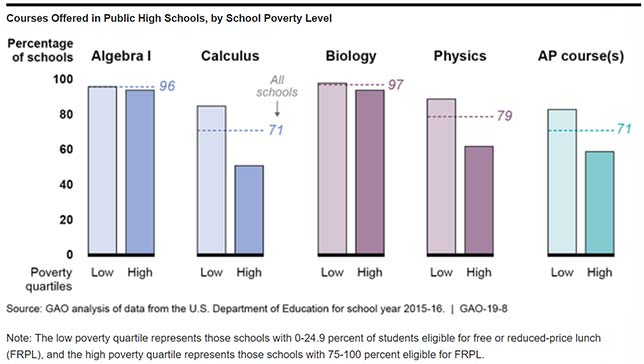High-Poverty Schools Face Academic Offering Challenges
A report from the U.S. Government Accountability Office finds public schools with more students in poverty are less likely to offer advanced course offerings that prepare students for college.
When it comes to preparing students for college, public high schools with higher student poverty rates may be putting their students at a disadvantage, according a new report from the U.S. Government Accountability Office. Based on a survey of Department of Education data, GAO found disparities in access were associated with the school poverty level of advanced courses like calculus, physics and courses that allow students to gain college credits.
In addition, smaller schools and charter schools also tend to offer fewer advanced math and science courses regardless of poverty level. While public four-year colleges expect students to complete three or four math and three or fourth science courses in high school, the GAO found the percentage of schools offering these courses decreased as poverty increased.
To conduct its analysis, the GAO took data from the department's Civil Rights Data Collection, which collects data on course offerings in schools and matched it with the department's Common Core of Data, which contains information on the percentage of students eligible for free and reduced lunch. Both datasets are from the 2015-2016 school year. The GAO also conducted site visits to 12 schools spread across California, Georgia and Wisconsin and interviewed state educational agency representatives by phone.
The results show that roughly 80 percent of the students in high-poverty schools were black or Hispanic compared to 20 percent of students enrolled in low-poverty schools. High-poverty schools represented 17 percent of all high schools in 2015-2016. As disparities in offering advanced math classes grew, school poverty levels also increased and a similar pattern emerged for science courses. High poverty schools were less likely to offer calculus, chemistry and physics.
For Advanced Placement courses, over 80 percent of low-poverty schools offered at least one course compared to 60 percent of high-poverty schools. For dual credit courses that allow high school students to earn credits toward college, 54 percent of high poverty schools had students enrolled compared to low poverty schools at 73 percent. School size also played a role in school offerings with 97 percent of large schools offering AP courses compared 68 percent of medium and 11 percent of small schools.

To mitigate the barriers that students face in high poverty schools, the GAO found some schools are taking remedial actions:
- Providing students with free access to college courses
- Online support for college advising
- Exhibiting a "college-going culture" to promote higher education
- Aligning high graduation requirements and college admission requirements
- Free college admission tests
- College initiatives to improve access and retention
The full GAO report can be found here.
About the Author
 Sara Friedman is a reporter/producer for Campus Technology, THE Journal and STEAM Universe covering education policy and a wide range of other public-sector IT topics.
Sara Friedman is a reporter/producer for Campus Technology, THE Journal and STEAM Universe covering education policy and a wide range of other public-sector IT topics.
Friedman is a graduate of Ithaca College, where she studied journalism, politics and international communications.
Friedman can be contacted at [email protected] or follow her on Twitter @SaraEFriedman.
Click here for previous articles by Friedman.